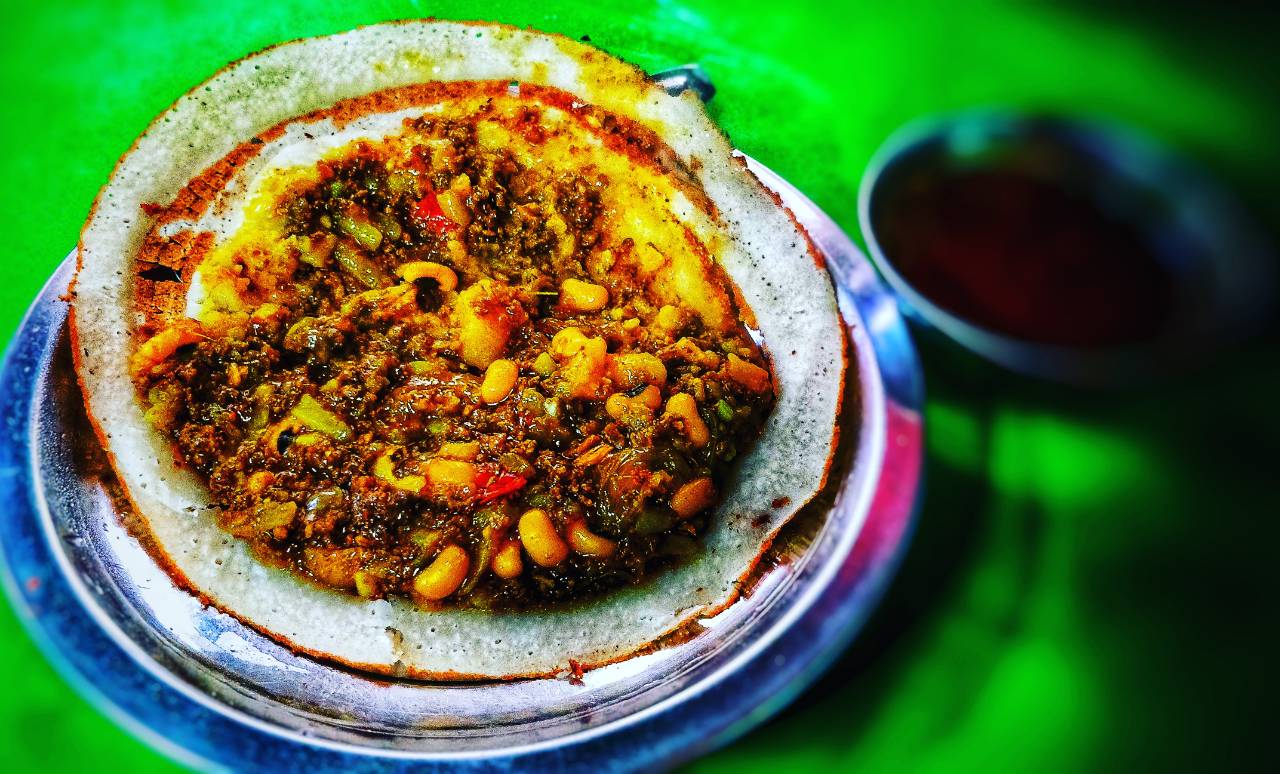Chatamari: “Newari pizza”

Chatamari, often dubbed the “Newari pizza,” is a beloved traditional dish from the Newar community of Nepal’s Kathmandu Valley. This savory rice flour crepe, topped with a variety of ingredients, is far more than a catchy nickname suggests. It’s a culinary emblem of Newari culture, steeped in tradition, and a versatile dish enjoyed during festivals, family gatherings, and as a popular street food. In this blog, we’ll explore the cultural significance of Chatamari in the Newar community and share an authentic recipe to bring its flavors to your kitchen.
Cultural Importance of Chatamari: “Newari pizza”
The Newar people, indigenous to the Kathmandu Valley, have crafted a rich cultural tapestry over centuries, with food playing a central role. Chatamari is a quintessential Newari dish, embodying the community’s culinary ingenuity and their emphasis on communal dining. Its significance goes beyond taste, intertwining with rituals, festivals, and social bonds.
A Dish for Special Occasions
Chatamari is traditionally prepared for special occasions, such as Jatras (festivals) and Sithi Nakha, a key Newari festival honoring Kumar, the son of Lord Mahadev and Goddess Parvati. During these events, families gather to cook and share Chatamari, reinforcing community ties. Its presence at celebrations symbolizes joy and togetherness, as it’s often enjoyed by all generations sitting together. The dish’s versatility—served with toppings like eggs, minced meat, or vegetables—makes it adaptable to various tastes, ensuring everyone at the table is included.
Chatamari: “Newari pizza” Symbol of Newari Culinary Heritage
Newari cuisine is renowned for its diversity, with over 200 dishes reflecting the fertile Kathmandu Valley’s bounty and the community’s sophisticated palate. Chatamari showcases this heritage through its simple yet flavorful base of rice flour, a staple in the region, combined with bold spices and local ingredients. The dish’s preparation reflects the Newar philosophy of cooking with intention, considering seasonal ingredients and nutritional needs. Its nickname, “Newari pizza,” while catchy, undersells its cultural depth, as Chatamari predates modern pizza and carries a distinct identity rooted in Newari traditions.
A Bridge Between Tradition and Modernity
Once reserved for festive occasions, Chatamari has evolved into a popular snack and street food, found in restaurants and roadside stalls across Kathmandu. This transition highlights the Newar community’s ability to preserve their culinary traditions while adapting to contemporary tastes. Today, Chatamari is enjoyed by Nepalis of all backgrounds, symbolizing the Newars’ cultural influence on Nepal’s broader gastronomic landscape. Its vegan and vegetarian variations also make it inclusive, aligning with modern dietary preferences while staying true to its roots.
Authentic Chatamari: “Newari pizza”
Recipe
Ready to experience the taste of Newari culture? Here’s a traditional recipe for Chicken Chatamari, with options for vegetarian or vegan variations. This recipe serves 4 and takes about 30 minutes to prepare.
Ingredients
For the Batter:
-
1 cup rice flour
-
1 ¼ cups water (adjust for a thin, crepe-like consistency)
-
½ tsp salt
-
1 tsp cumin powder
-
½ tsp turmeric powder (optional, for color)
For the Topping (Chicken):
-
200g ground chicken (or buffalo for authenticity)
-
1 small onion, finely chopped
-
2 tbsp cilantro, chopped
-
1 tsp ginger-garlic paste
-
½ tsp cumin powder
-
½ tsp coriander powder
-
½ tsp red chili powder (adjust to taste)
-
½ tsp meat masala (optional)
-
Salt to taste
-
1 egg (optional, for topping each Chatamari)
Vegetarian/Vegan Alternatives:
-
Replace chicken with diced mushrooms, paneer, or mixed vegetables (e.g., corn, tomatoes, bell peppers).
-
For vegan, skip the egg and use sugar or mashed potatoes as a sweet or savory topping.
For Cooking:
-
2–3 tbsp vegetable oil
Instructions
-
Prepare the Batter:
-
In a large bowl, mix rice flour, salt, cumin powder, and turmeric powder.
-
Gradually add water, whisking to form a smooth, thin batter (similar to crepe batter). Let it rest for 10 minutes.
-
-
Prepare the Chicken Topping:
-
In a bowl, combine ground chicken, onion, cilantro, ginger-garlic paste, cumin, coriander, chili powder, meat masala, and salt. Mix well and set aside.
-
For vegetarian/vegan versions, sauté vegetables or paneer with the same spices until lightly cooked.
-
-
Cook the Chatamari:
-
Heat a non-stick skillet or flat pan over medium heat and lightly grease with ½ tsp oil.
-
Pour a ladleful of batter (about ¼ cup) into the pan, swirling to form a thin, round crepe (6–8 inches in diameter).
-
Immediately spread a portion of the chicken mixture (or vegetarian topping) evenly over the batter. If using an egg, crack one over the topping and spread gently.
-
Cover the pan and cook for 3–4 minutes on medium heat until the batter is set and the edges are crispy. Chatamari is typically cooked on one side only.
-
-
Serve:
-
Transfer the Chatamari to a plate and garnish with extra cilantro if desired.
-
Serve hot with a side of spicy achar (Nepali pickle) or yogurt for dipping.
-
Repeat for the remaining batter and topping.
-
Tips for Success
-
Ensure the batter is thin but not runny to achieve a crispy yet tender base.
-
Adjust spices in the topping to your preference; Newari cuisine often leans bold and spicy.
-
For an authentic touch, cook on a traditional tawa (flat iron griddle) if available.
-
Experiment with toppings like minced buffalo, cheese, or even sweet fillings like molasses for a unique twist.
Why You Should Try Chatamari
Chatamari is more than a dish—it’s a gateway to understanding the Newar community’s vibrant culture. Its crisp rice base, flavorful toppings, and communal appeal make it a delight for foodies and cultural explorers alike. Whether you’re savoring it at a Kathmandu eatery or recreating it at home, Chatamari offers a taste of Nepal’s rich heritage. So, gather your ingredients, invite some friends, and celebrate the Newari way with this timeless delicacy!
Have you tried Chatamari before, or are you inspired to make it? Share your thoughts or variations in the comments below!
